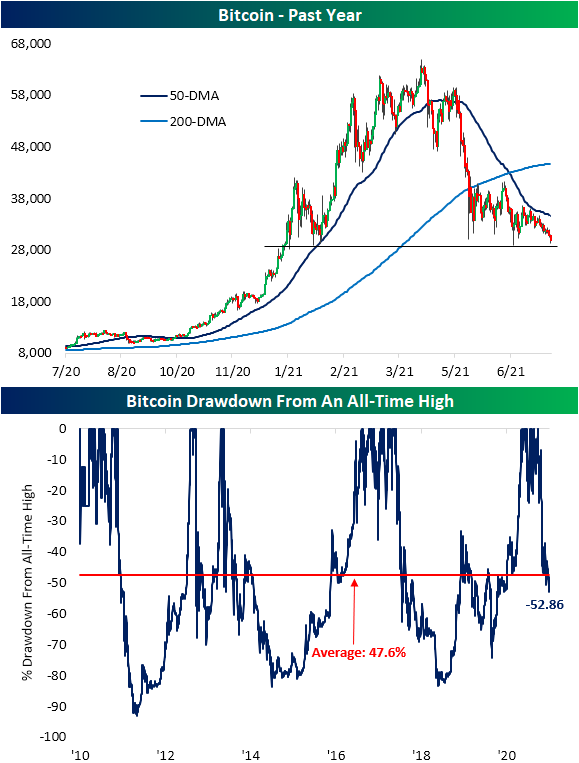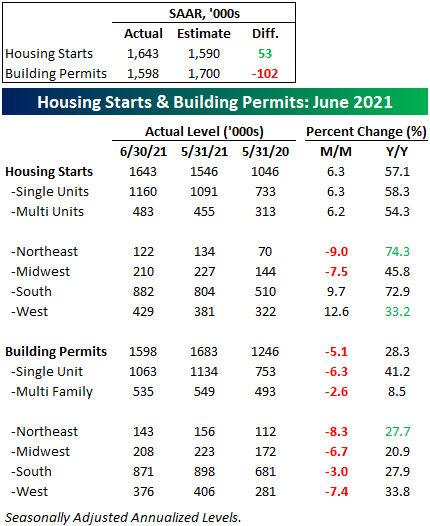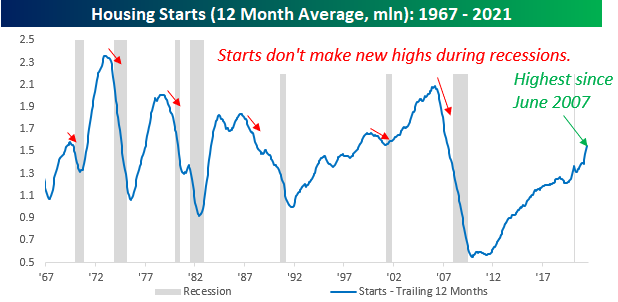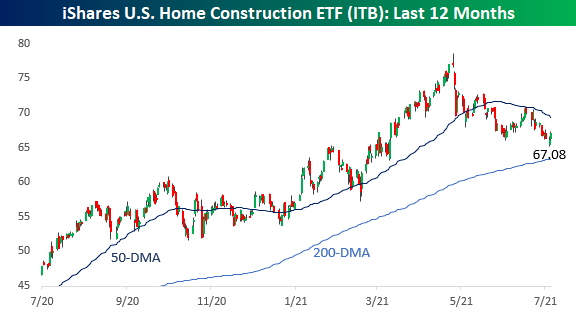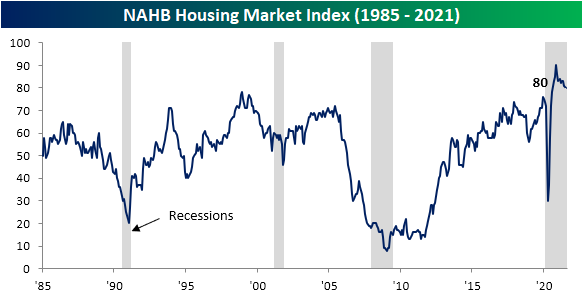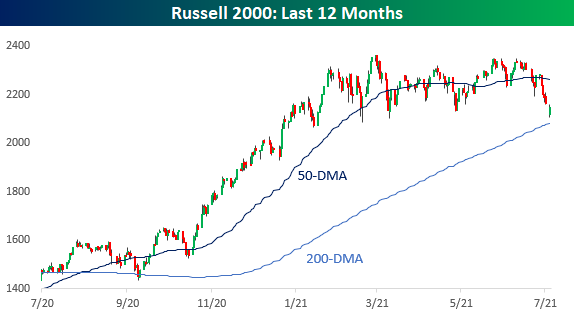Bespoke’s Morning Lineup – 7/21/21 – Sector Performance All Over the Place
See what’s driving market performance around the world in today’s Morning Lineup. Bespoke’s Morning Lineup is the best way to start your trading day. Read it now by starting a two-week free trial to Bespoke Premium. CLICK HERE to learn more and start your free trial.
“The market does not beat them. They beat themselves, because though they have brains they cannot sit tight.” – Jesse Livermore
Futures were higher across the board earlier but have given up some of their gains heading into the open as the Nasdaq is now indicated to open modestly lower. Small caps are continuing to build on yesterday’s gains with the Russell 2000 indicated to open up more than 0.7% as investors reassess whether concerns over the Delta variant were a bit overdone.
Read today’s Morning Lineup for a recap of all the major market news and events from around the world, the latest US and international COVID trends including our vaccination trackers, and much more.
It’s not often that the spread in 5-day performance between the best and worst-performing sectors in the market is over 10 percentage points, but that is where things stand heading into today’s trading. While Energy is down over 9% in the last five trading days, three sectors (Utilities, Real Estate, and Consumer Staples) are all up over 1% in the last week. Despite its recent sell-off, Energy is still one of the top-performing sectors in the S&P 500 this year with a gain of over 28%. While the losses in Energy have been painful, one could still argue that the sector remains in a consolidation mode following its monster gains off the late 2020 lows. Technology, meanwhile, remains right in the middle of the pack in terms of YTD performance, but in the short-term is one of the most overbought sector’s trailing only Health Care.

Bitcoin Drawdown
In today’s Morning Lineup, we detailed how the total market cap of crypto is reaching new lows in the context of a multi-month unwind. That is as the largest cryptocurrency, Bitcoin, falls below 30,000 for the first time since January 1st. Granted, back then Bitcoin had never been that high before. Today, Bitcoin is down for the fourth day in a row nearing extreme oversold territory (measured by 2 or more standard deviations below its 50-DMA) and is testing support around the lows from earlier in the spring. That all leaves Bitcoin 52.86% below its all-time high above 63,000 from April 15th. While the price of the crypto being cut in half may sound dramatic, as we have noted in the past, it is more or less par for the course for the speculative asset. As shown in the second chart below, through its history the average decline from an all-time high has been 47.6% (median 51.9%); only a few percentage points less than the current drawdown. Click here to view Bespoke’s premium membership options.
Strong Starts, Some Building Weakness In Permits
This morning’s release of Housing Starts and Building Permits for the month of June was mixed relative to both last month’s levels and expectations, but the overall trends remain positive. Starting out with the details, Housing Starts rose 6.3% versus March and topped expectations by 53K (1.643 million vs 1.590 million). Building Permits, meanwhile, missed expectations by nearly twice the amount that Starts beat expectations (1.598 million vs 1.7 million), and they also fell just over 5% relative to May.
In terms of single versus multi-family units, Housing Starts saw a uniform increase rising just over 6%, but on a regional basis, strength was seen in the West and South, while both the Northeast and Midwest experienced high single-digit declines. Building Permits were weaker at the single-family level than the multi-family level, which could be a result of higher input costs. On a regional basis, though, Permits were down all over the country with the South seeing the most modest declines.
One note regarding the miss in Permits – although they were lower than Starts in June, they were higher than Starts in each of the past 15 months, so they have been running at a stronger pace than Starts for quite some time. Click here to view Bespoke’s premium membership options and receive a more detailed analysis of economic data.
As far as overall trends in Housing Starts and Permits are concerned, the longer-term trend remains positive. Housing Starts are a great leading indicator of the business cycle, and the 12-month average continued to surge to new multi-year highs in June reaching the highest level since June 2007.
Zooming in on just the last ten or so years, both Housing Starts and Building Permits experienced a brief dip in the aftermath of the COVID outbreak but quickly resumed their upward trend and have been accelerating to the upside. Also, barring a complete cratering of the monthly numbers, these 12-month averages should continue to rise in the months ahead.
Single-family Housing Starts and Building Permits are rising at an even faster rate. Also notable is that despite the fact that there was a notable divergence between Building Permits and Housing Starts this month, the 12-month average of single-family Starts and Permits were practically the same (1.130 million vs 1.138 million).
The fundamental backdrop for Housing Starts and Building Permits may still look positive, but homebuilder stocks have been under pressure lately after an insanely strong rally earlier in the year. Since its peak in early May, the iShares Home Construction ETF (ITB) has dropped 15% in a series of lower highs and lower lows.
Higher labor and input costs have weighed on sentiment for the sector, but some of the input costs have reversed and lower interest rates should also act as a tailwind. Looking at a longer-term chart, there has been a positive correlation between Housing Starts relative to the performance of ITB, and as these charts illustrate, while the short-term picture for ITB (above) looks somewhat ominous, the longer-term picture looks much more benign. As shown below, the recent pullback in ITB looks more like a reversion to the mean as they got a bit ahead of themselves earlier this year. One trend to keep in mind going forward for the homebuilders is that if the recent price declines for housing inputs remain in place, they have the potential to see some significant improvements to margins if they can continue to command higher prices.
The Health Care Tortoise and the Hare
When COVID first started to worry equity markets in early 2000, one of the names investors immediately flocked to was telehealth provider Teladoc (TDOC). TDOC was the perfect COVID play as it enabled people to continue seeing doctors through digital means at a time when the world was locked down. TDOC actually performed very well in the normal months leading up to COVID, and shares continued to shoot higher even as the broad market declined in late February and March 2020. By early August 2020, TDOC was up over 100% since 2/19/20 — the date of the high point for the S&P just prior to the COVID Crash. After a consolidation period in the fall and early winter 2020, TDOC went on another run from December through February of this year and was up nearly 150% YoY on February 19th of this year.
While TDOC was a beloved stock during the first stages of the COVID pandemic, it has been a serious drag over the last five months. Since peaking in mid-February, shares are down roughly 50% from their highs. Notably, as TDOC has been falling this year, traditional health care providers like hospital company HCA and healthcare provider and insurer UnitedHealth (UNH) have been rallying to new highs. As shown below, the six-month chart patterns for HCA and UNH couldn’t look more different than the chart of TDOC. Click here to view Bespoke’s premium membership options.
What we find most surprising is that Teladoc (TDOC) is now underperforming both HCA and UNH since 2/19/20 when SPY hit its pre-pandemic high just before COVID began worrying markets. As shown below, at one point earlier this year, TDOC was outperforming its traditional health care competitors by more than 100 percentage points. That outperformance has been fully erased over the last five months. Since 2/19/20, TDOC is now up just 29% versus gains of 45% for HCA and 34% for UNH.
Last year there was a lot of talk about telehealth becoming one of the biggest long-term trends that we’d see accelerate because of COVID. That trend could certainly continue over the coming years and decades, but TDOC’s recent performance just goes to show you that sometimes the best-laid plans don’t necessarily play out the way investors may expect them to, and past performance is certainly not indicative of future performance over any time frame.
Of course, we should note that going back further over the last five years, TDOC is still significantly outperforming both HCA and UNH. In fact, TDOC is a 10-bagger over the last five years with a gain of 1,183%, while HCA and UNH have also performed well but are only up 169% and 206%, respectively.
Bespoke’s Morning Lineup – 7/20/21 – Do Over
See what’s driving market performance around the world in today’s Morning Lineup. Bespoke’s Morning Lineup is the best way to start your trading day. Read it now by starting a two-week free trial to Bespoke Premium. CLICK HERE to learn more and start your free trial.
“The definition of insanity is doing the same thing over and over again, but expecting different results.“ – Albert Einstein
While it wasn’t the only factor behind yesterday’s decline, a key event that spooked many investors (and computers) was a comment from UK Chief Scientific Adviser Sir Patrick Wallace who said that 60% of UK COVID hospitalizations were fully vaccinated. Later in the day, shortly before the US close, he clarified his remarks to say that his numbers were reversed and that less than 40% of all hospitalizations were fully vaccinated. That was a pretty big error, but one that caused some relief on the part of investors as stocks finished off their lows of the afternoon.
Today, futures are higher again, but still well below where they closed Friday. Rising COVID cases have been one driver of the weakness but not the only headwind facing the market. In the short term, investors will also have to contend with weak seasonal trends as well as high expectations heading into earnings season.
Read today’s Morning Lineup for a recap of all the major market news and events from around the world, the latest US and international COVID trends including our vaccination trackers, and much more.
One thing that’s been happening over and over again in the market is that every time the S&P 500 tests its 50-day moving average (DMA), it has managed to bounce. Over the last year, there have only been two times where the S&P 500 closed below its 50-DMA and continued to decline meaningfully from there. Both of those occurrences were last year. Before yesterday, there were six other times this year where the 50-DMA came into play and each time the S&P 500 bounced significantly from there. Obviously, this can’t keep going on forever, but in the short-term, but until it doesn’t work anymore, the ‘buy the dippers’ will likely stick with what has worked.

Stocks For the COVID Economy Check Up
In early March of last year, we highlighted an initial basket of stocks whose businesses aligned with pandemic trends which we aptly named: Stocks for the COVID Economy. We have periodically checked back in on these stocks since initially debuting the list, and seeing as COVID fears are once again a driver of price action again today, we thought we would check back in on the stocks for the COVID economy.
While the S&P 500 is set to close down roughly 2% on the day, the stocks listed in the table are down an average of just 2 basis points. A third of the stocks listed are in the green on the day even though the S&P 500’s net advance/decline reading is -437. Stay-at-home names like Chewy (CHWY), Peloton (PTON), Teladoc (TDOC), and Chegg (CHGG) are all leading the way higher today with gains of more than 2%. MarineMax (HZO), FedEx (FDX), Regeneron (REGN), DR Horton (DHI), and Campbell Soup (CPB) are all higher on the day as well. If it were not for its Five9 (FIVN) acquisition announcement, we think Zoom (ZM) would likely also be higher. Click here to view Bespoke’s premium membership options.
Homebuilder Sentiment Strong But Sliding
Homebuilder sentiment peaked back in November with the NAHB’s Housing Market index topping out at 90. In the time since then, it has reversed lower by 10 points to 80 this month with higher prices and various shortages being the main reason reported by the NAHB for the decline. The drop leaves the index at the lowest level since last August, although it’s still above any pre-pandemic reading. In short, homebuilders remain historically optimistic but not to the same extent that they were in late 2020.
Playing into that decline in the headline number was a single point drop in Present Sales and a much larger six point decline in Traffic. The Present Sales index, which has the highest weighting on the headline number at nearly 60%, fell to 86 which ties the pre-pandemic record high from December 1998. The Traffic Index holds the second-largest weight at roughly 27%, and its larger decline was the main driver of the overall drop in sentiment. This month’s decline was particularly large ranking in the 3rd percentile of all monthly moves. Although traffic has moved sharply lower, it too remains healthier than any period prior to the pandemic. One other silver lining is that Future Sales rose 2 points to move back above 80. While that is far from setting any sort of new high as the index still needs to climb another eight points to reach its record, it does point to some improvement in homebuilder outlook.
Looking across each of the four regions broken up by the report, only the Midwest saw an overall improvement in July whereas each of the others fell by 2 points. Once again, those drops still leave the indices at historically solid levels.
Even though the NAHB’s reading on homebuilder sentiment headed lower once again this month and there is a broader weakness across equities today, the S&P Homebuilders (XHB) has managed to so far hold up at support. As shown below, XHB tested support at the June low near $69 on the initial drop at this morning’s lows. That will continue to be a level to watch going forward, although it is also in a bit of a no man’s land. XHB currently finds itself smack dab between its 50 and 200-DMAs.
As for any catalysts to change that, hard data on housing starts will be released tomorrow and earnings are certainly another. As shown in the snapshot of our Earnings Explorer tool below, there are a handful of XHB stocks scheduled to report over the next week, and many others are also scheduled over the next few weeks. For the most part, these stocks have averaged positive reactions to earnings with D.R. Horton (DHI) averaging the strongest stock price reaction of any of those reporting this week. Click here to view Bespoke’s premium membership options.
Small Caps Enter Correction Territory
While the S&P 500 may still be within a couple of a percent of its record high from a week ago today, the magnitude of the decline in small caps has been much larger. While it has seen a bit of a bounce intraday, at the open today, the Russell 2000 was down over 10% from its record closing high in mid-March. While the Russell 2000 is one of the worst-performing US indices in recent months, it remains within the range it has been trading in all year.
From a technical perspective, we consider a correction to be any decline of 10% (on a closing basis) from a closing high without a rally of 10% in between. While the Russell 2000 was down 10% earlier today, if the current levels hold, it won’t quite reach the correction threshold on a closing basis. In the chart below, we show every correction for the Russell 2000 going back to 1980 and its magnitude in percentage terms. During this time, the Russell 2000’s average decline during a correction has been 18.2% (median: 15.4%), so with the current decline currently not even at 10%, there’s a decent amount of room between here and average levels.
While we may not be there in terms of the size of the decline, in terms of duration, the current period is already well above average. The Russell’s closing high was all the way back on March 15th, so even if the decline ended today, it would be 126 calendar days, or more than 50 days longer than the average of 73 days and double the median of 63 days.
In the chart below, we show Russell 2000 corrections in terms of their duration in calendar days. What’s really interesting to note about the current period is that at 126 days, it already would rank as the 7th longest correction in the Russell’s history. When it comes to corrections, we always highlight that they can occur in terms of both time and/or price. For the current period, it has certainly been a combination of the two, but to this point, it has been more centered on time than on price. Click here to view Bespoke’s premium membership options.
The COVID Trade Is Back
Each of the major indices are down well over 1% with the Dow and small-cap Russell 2,000 down even more having fallen over 2% as of this writing. Meanwhile, Treasury yields are falling and at multi-month lows. The main reason being attributed to the risk-off move today is jitters over the rising prevalence of the Delta variant. To give some evidence to this being the catalyst, in the chart below we show the relationship between individual S&P 500 stocks’ performance today and back during the COVID crash from February 19th to March 23rd of last year. As shown, there is a general correlation that exists between the performance of the two periods. Some of the best performers today were also some of the best performers during the crash and vice versa. For example, Consumer Staples was the sector that held up the best during the COVID Crash last year with the average stock in the sector falling 24.04% versus an average decline of 38.7% for the entirety of the S&P 500. Today, several of the sector’s names are the top performers on the day as the average stock in the sector is only down 19 bps versus an average decline of nearly 2% for all S&P 500 stocks. Click here to view Bespoke’s premium membership options.
Bespoke’s Morning Lineup – 7/19/21 – 1.23%
See what’s driving market performance around the world in today’s Morning Lineup. Bespoke’s Morning Lineup is the best way to start your trading day. Read it now by starting a two-week free trial to Bespoke Premium. CLICK HERE to learn more and start your free trial.
“Change before you have to.” – Jack Welch
It’s not looking like a fun start to the trading week for bulls. After falling 300 on Friday, Dow futures have already tacked on another 500 points to that drop and we’re still an hour from the open! S&P 500 and Nasdaq futures are down by significant but not as large amounts, but the real area of pain is in small caps where the Russell 2000 is indicated to open down by more than 2.25%. At that level, the Russell would be down by slightly more than 10% from its 52-week high.
Read today’s Morning Lineup for a recap of all the major market news and events from around the world, the latest US and international COVID trends including our vaccination trackers, and much more.
As COVID case numbers rapidly rise across the country and the world, concerns over the trajectory of the recovery have been called into doubt. That trend has only intensified in the last few days, and the yield on the 10-year US Treasury is a perfect example. This morning, the yield is down to 1.23%, which is the lowest since February 16th!

If current levels on the 10-year hold, it will end a streak of 172 trading days where the yield closed above its 200-day moving average. Relative to history, this current streak was nowhere near extreme, but it was the longest streak since December 2018.


